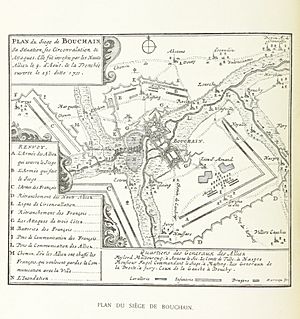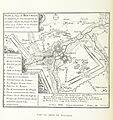Siege of Bouchain (1711) facts for kids
Quick facts for kids Siege of Bouchain |
|||||||
|---|---|---|---|---|---|---|---|
| Part of the War of the Spanish Succession | |||||||
 |
|||||||
|
|||||||
| Belligerents | |||||||
| Commanders and leaders | |||||||
| Strength | |||||||
| 30,000 | 5,000 | ||||||
| Casualties and losses | |||||||
| 3,000 killed |
|
||||||
The Siege of Bouchain was an important battle during the War of the Spanish Succession. It happened between August 5 and September 12, 1711. This battle was the last big win for John Churchill, 1st Duke of Marlborough, a famous British general.
Marlborough, along with Dutch commander François Nicolas Fagel, led their armies to break through strong French defenses. They then captured the town of Bouchain after a 34-day siege. This victory was a major step for the Allied forces. After Bouchain fell, only Cambrai stood between the Allied army and the French capital, Paris.
Contents
What Happened Before the Siege?
Marlborough's Plan to Break French Lines
In the summer of 1711, Duke of Marlborough's army was in northern France. They faced the "Lines of Ne Plus Ultra." These were huge French defensive walls and trenches. They stretched from the English Channel all the way to Namur.
The Allied army was a bit weaker than usual. This was because Prince Eugene's army had to leave. They went to protect the River Rhine area. This happened after the Emperor Joseph died, causing some trouble.
Capturing and Losing Arleux
On July 6, Marlborough captured a small fort called Arleux. It was just north of the French lines. Taking Arleux helped secure water for Douai, another important town. It also stopped the French from using it to attack.
However, the French general Villars outsmarted Marlborough. On July 22-23, the French army crossed their lines. They quickly took back Arleux. The Allied army was too far away to stop them. The French then destroyed Arleux's defenses before going back behind their lines.
Marlborough's Clever Move
Marlborough was first very angry. But he soon got back his advantage. He made his army look like they were going to attack the French lines near Arras. He even did a detailed check of the area on August 4. Villars and his army watched him do this.
That night, Marlborough's army secretly packed up camp. They left their campfires burning to trick the French. Then, they marched east towards Arleux. Around midnight, a group from Douai, led by Cadogan, crossed the unguarded French lines. By 8 AM, the main Allied army was also crossing over.
Villars arrived with some cavalry and realized he had been tricked. He tried to fight Marlborough's army near Bourlon Wood. But Marlborough chose not to attack. Villars' position was very strong there. It was even stronger than where Marlborough had faced a tough fight at Malplaquet two years before. So, Villars moved away. He then tried to stop Marlborough from besieging Bouchain.
The Siege of Bouchain
Defending the Town
Bouchain was a very strong fortress. It was surrounded by marshy land where the Scheldt and Sensée rivers met. The town's governor, de Ravignan, had about 5,000 soldiers. Marlborough's army, however, had 30,000 men.
General Villars' strong French army was positioned west of the Allied camp. He managed to keep a weak connection open to the soldiers inside Bouchain. This allowed some communication and supplies to get through.
Allied Tactics and Victory
Fagel, the Dutch commander in charge of the siege, used smart tactics. He set up earthwork gun batteries to counter Villars' army. On August 18, a special Allied attack force managed to cut off Villars' connection to Bouchain again.
Fagel also created a safe path from the siege camp to their main supply port. This port was at Marchiennes, on the Scarpe river. Villars often raided the supply convoys on the Scarpe and tried to attack Douai. But his efforts failed to stop the siege.
Finally, on September 13, 1711, the French soldiers in Bouchain surrendered. They marched out of the town and became prisoners of war.
What Happened After the Siege?
Marlborough's Final Campaign
The Siege of Bouchain was Duke of Marlborough's last military campaign. On the very last day of 1711, he lost his position as Captain-General. He also lost all his other important jobs.
For the 1712 campaign, command of the army went to the Duke of Ormonde. Strict rules were put on him. He was told not to fight the French in battle. This was because peace talks between Britain and France were already happening.
The chance to capture Cambrai and march on Paris, which Marlborough's wins had opened up, was given up. Before the year ended, the British Army left the alliance. The remaining Allied forces, led by Eugene of Savoy, were later defeated at the Battle of Denain.
Bouchain Recaptured
The next year, on October 19, 1712, French forces took Bouchain back. This was done by Marshal Villars after an 18-day siege.
Images for kids


